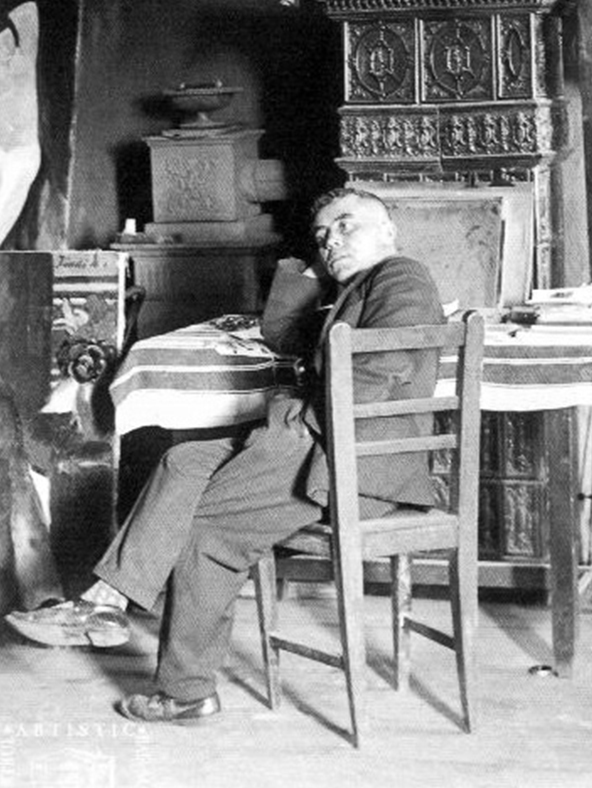Jándi (Léderer) Dávid

Jánd (Bereg), 1893 - 1944
The Life
Beyond the anecdotes, little is known about Jándi and his life, dedicated entirely to art.
The Art
Most considered him an artist in training or continuously seeking to define his own style, whose direction was unclear. Nevertheless, in his work, he gave shape to the entire human drama.
Léderer Dávid becomes Watermelon David
He was born under the name of Léderer Dávid in Jánd, Bereg County, Hungary. He and his family moved to Nyíregyháza, where he went to school and heard about the famous school of painting from Baia Mare. Although his family was not thrilled with his inclination towards painting, the young man left in 1911 for Baia Mare
Here, he was lucky to have met Professor Thorma János, who took him under his wing and who thought of him to have great artistic potential. The teacher took the student to his parties, as the writer Tersánszky Józsi Jenő captured.
In the colony, they called him “Dinnye Dávid” (Watermelon David), because he ate a lot of this fruit. And, because of his small stature and tumultuous temperament, he was the character of many anecdotes.
The beginning of his career
The beginning of the artist's career is linked to the scandal that broke out in the press in 1911. In this scandal, Boromisza Tibor, a prominent representative of the "neo-Christians", accused the founders of the colony, Thorma János, and Réti, of conservatism. The legendary period of the "Baia Mare dismount" had already passed, when Plein-air painting was the pinnacle of modern Hungarian art. The new generations of artists had to face both the problems of the last years of peace and the challenges that the avant-garde brought.
The exhibition in 1911, in the Ferenczy studio, where he presented his works, together with Apáti Abkarovits Béla and Jeremiás Nándor, was greeted by a journalist who made this observation: “He has the temperament, bold plans, thinks in large compositions and likes to learn a lot.” It seems that he actually captured a constant of his art, which is all the more surprising as he did it at a zero moment in Jándi's career.
It was from the next year that the young man started signing his works as Jándi Dávid. According to his monographs, Szücs György and Zwickl András, it was not just the choice of a Hungarian name, but the full assumption of a new identity, that of a painter.
The beginning and the end of the war
The beginning of the war interrupted his promising beginning and, more than that, he was enlisted. From the war, two sketchbooks were brought to light, having a great value. It was in these sketches from 1911 and 1923 that we noticed the predilection for biblical themes (The Descent from the Cross), captured in pen. The agitation of the figures in the compositions makes us think of Michelangelo. In 1931, the artist declared: “There I was able to see again, face to face, my forever and only master, Michelangelo. In his footsteps and his spirit, I want to work in my whole life." (Keleti Újság, September 13, 1931, no. 208). His predilection for dynamic compositions of Mannerist origin dates from the early years and is present until the end of his life.
At the end of the war, during which it is believed he has been deported to Siberia, the artist settled in Nyíregyháza, then in Budapest. He spent his days living in two places: in Budapest, where he participated in exhibitions, and Baia Mare, his permanent source of inspiration.
Critics and critics
In 1923, he presented at the Belvedere Gallery in Budapest a personal exhibition consisting of extensive compositions, with many figures of which the most successful were "The Lamentation of Christ", "The Burial” and “Bacchanalia”. “Susana and the Elders”, the work from our collection, was also presented in this exhibition.
Some critics emphasized Jándi's interest in composition, in the tumultuous and dynamic scenes. Others, his compositional mistakes and exaggerations in exposing the complexion of the flesh. Most considered him an artist in training, whose direction was unclear. The atmosphere of his scenes was characterized as "gloomy, Old Testament atmospheres." (Világ, Budapest, January 28, 1923). The cycle of the great allegorical scenes of mythological and biblical inspiration started in 1923 and ended in 1930, with the painting “Ego Sum”.
While artists in the new wave of neoclassicism sought after the war to find a lost Arcadia and envelop their landscapes and scenes in a transcendent light that offers hope, Jándi’s compositions were dominated by convulsed fleshy forms, as if made of clay, on which fell strong accents of light, which allow their identification. They did not allow themselves to be completely lost in the dark. Jándi’s brave color choice was fully manifested in pastel - landscapes, nudes, and compositions.
In the first exhibition of the Guild Barabás Miklós from Cluj, of which he was a founding member, he presented “Ego Sum”. Unlike the first dark works in this series, he used colors with bright metallic accents. The press mentioned about this exhibition that the artist made compositions whose characters exploded with energy and that the scenes were very dynamic, the artist exaggerating to the point of pathos. Exactly the temperament, dynamism, and strength are those characteristics by which Jándi emerged from the "goodness" and balance of Hungarian neoclassical painting.
The greatest works
The „Abduction of the Sabines” and „Susana and the elders” from our collection are outstanding achievements of this series. The “Ghetto” was probably made in his last month of life, in the Baia Mare ghetto. It resumes once again the dynamism of the first compositions with many figures. He used a figure or even whole scenes as a quote and we can find motifs of biblical connotations, such as "Mother with child" and "Dinner". We can also feel the improvised and ominous atmosphere of the ghetto, before deportation.
The artist was shot in Baia Mare while trying to escape the train taking the local Jewish population to the extermination camps in Europe.






